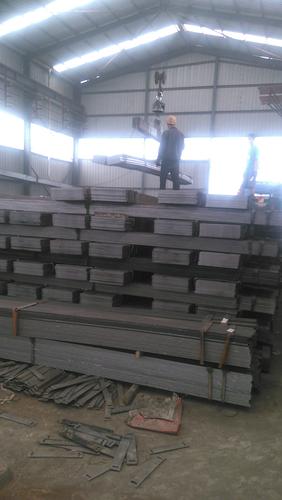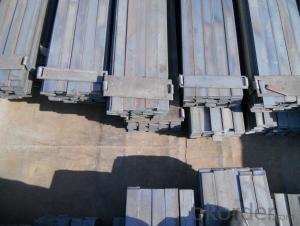Steel Flat Bar JIS Standard Grade SS400B
- Loading Port:
- Tianjin
- Payment Terms:
- TT or LC
- Min Order Qty:
- 50 m.t.
- Supply Capability:
- 10000T m.t./month
OKorder Service Pledge
OKorder Financial Service
You Might Also Like
Product Description:
OKorder is offering Steel Flat Bar JIS Standard Grade SS400B at great prices with worldwide shipping. Our supplier is a world-class manufacturer of steel, with our products utilized the world over. OKorder annually supplies products to African, South American and Asian markets. We provide quotations within 24 hours of receiving an inquiry and guarantee competitive prices.
Product Applications:
Steel Flat Bar JIS Standard Grade SS400B are ideal for structural applications and are widely used in the construction of buildings and bridges, and the manufacturing, petrochemical, and transportation industries.
Product Advantages:
OKorder's Steel Flat Bar JIS Standard Grade SS400B are durable, strong, and wide variety of sizes.
Main Product Features:
· Premium quality
· Prompt delivery & seaworthy packing (30 days after receiving deposit)
· Can be recycled and reused
· Mill test certification
· Professional Service
· Competitive pricing
Product Specifications:
Manufacture: slited
Slitting precision (width) : 0.5 mm or less
Raw material: Q235B, Q345B, Q235-1 b
crosscutting precision (length) : 2 mm or less
Processing: the thickness of 2.0-16 mm;
Shear length: 2000 mm above
Wide degree: 15-1250 - mm;
Leveling precision: 1-2 MM square
Packaging: Export packing, nude packing, bundled
FAQ:
Q1: Why buy Materials & Equipment from OKorder.com?
A1: All products offered byOKorder.com are carefully selected from China's most reliable manufacturing enterprises. Through its ISO certifications, OKorder.com adheres to the highest standards and a commitment to supply chain safety and customer satisfaction.
Q2: How many tons of steel products could be loaded in containers?
A2: Usually the steel products are delivered by bulk vessel because of the large quantity and the freight. However, there are no bulk vessel enter some seaports so that we have to deliver the cargo by containers. The 6m steel product can be loaded in 20FT container, but the quantity is changed according to the size, usually from 18tons to 25tons.
Q3: How soon can we receive the product after purchase?
A3: Within three days of placing an order, we will arrange production. The normal sizes with the normal grade can be produced within one month. The specific shipping date is dependent upon international and government factors, the delivery to international main port about 45-60days.
Images:


- Q: How do you determine the strength of a steel flat bar?
- The strength of a steel flat bar can be determined through various methods, including tensile testing, hardness testing, and yield strength calculations. Tensile testing involves subjecting a sample of the flat bar to a controlled pulling force until it reaches its breaking point, measuring the maximum stress it can sustain. Hardness testing measures the material's resistance to indentation, providing an indication of its strength. Yield strength calculations involve determining the stress at which the steel begins to exhibit permanent deformation. By utilizing these methods, the strength of a steel flat bar can be accurately determined.
- Q: Can steel flat bars be used for staircase construction?
- Yes, steel flat bars can be used for staircase construction. They are commonly used as stringers or supports for the steps, providing strength and durability to the staircase structure.
- Q: What are the common industries that use steel flat bars?
- The common industries that use steel flat bars include construction, manufacturing, automotive, aerospace, and mining.
- Q: Can steel flat bars be used for manufacturing conveyor systems or belts?
- Yes, steel flat bars can be used for manufacturing conveyor systems or belts. Steel flat bars are often used as support structures or frames in conveyor systems. They provide a sturdy and durable base for the conveyor belts to run on. The flat surface of the steel bars allows for smooth movement of the belts, ensuring efficient and reliable transportation of goods or materials. Additionally, steel is known for its strength and resistance to wear and tear, making it an ideal choice for conveyor systems that require heavy-duty operations. Overall, steel flat bars are a suitable material for manufacturing conveyor systems or belts due to their strength, durability, and smooth surface.
- Q: What are the different international standards for steel flat bars?
- Steel flat bars are subject to various international standards that guarantee their quality and specifications. Some commonly followed standards are as follows: 1. ASTM International (American Society for Testing and Materials): A widely used standard is ASTM A36/A36M, which specifies the requirements for steel flat bars made from carbon structural steel. It covers dimensions, tolerances, chemical composition, mechanical properties, and other relevant aspects. 2. European Norm (EN): The EN 10058 standard is applicable to hot-rolled flat steel bars with a width of 15 mm and above, and a thickness of 1 mm and above. It specifies the tolerances, dimensions, and technical delivery conditions for these bars. 3. Japanese Industrial Standards (JIS): In Japan, the JIS G3194 standard is employed for hot-rolled flat steel bars. It covers the classification, dimensions, and tolerances of these bars, as well as the permissible variations in chemical composition and mechanical properties. 4. British Standards (BS): The BS EN 10025-2 standard delineates the technical delivery conditions for non-alloy structural steels, including flat bars. It encompasses dimensions, tolerances, chemical composition, and mechanical properties, thereby ensuring the quality and performance of these bars. 5. International Organization for Standardization (ISO): ISO 1035-3 provides guidelines for hot-rolled steel bars, including flat bars, manufactured from unalloyed or low-alloy steels. It encompasses the dimensions, tolerances, and technical delivery conditions for these bars. These examples represent a fraction of the international standards that oversee the production, quality control, and specifications of steel flat bars. By adhering to these standards, manufacturers ensure that their products demonstrate consistency, reliability, and compatibility in global markets.
- Q: Are steel flat bars available in different colors or finishes?
- No, steel flat bars are typically not available in different colors or finishes. Steel is primarily used for its strength and durability, rather than its aesthetic appeal. However, there are some instances where steel flat bars can be painted or powder coated in different colors for decorative purposes. Additionally, steel can be treated or coated with different finishes such as galvanized or stainless steel for improved corrosion resistance.
- Q: What is the difference between a steel flat bar and a steel channel?
- A steel flat bar and a steel channel are both structural steel shapes, but they have distinct differences in their shape and design. A steel flat bar is a long, rectangular-shaped piece of steel with straight edges. It is commonly used in construction and manufacturing industries for various applications such as braces, supports, and frames. The flat surface of the bar provides stability and strength, making it suitable for load-bearing purposes. The width and thickness of a flat bar can vary depending on the specific requirements of a project. On the other hand, a steel channel is a C-shaped structural component with two flanges and a web in the middle. The flanges are perpendicular to the web, giving the channel its distinctive shape. Channels are widely used in construction, particularly in the framing of buildings and the creation of structural support systems. The flanges provide strength and rigidity to the channel, making it suitable for applications where lateral support and stability are required. In summary, the main difference between a steel flat bar and a steel channel lies in their shape and structural design. While a flat bar is a long, rectangular piece with straight edges, a channel has a C-shaped profile with flanges and a web. The choice between the two depends on the specific requirements of a project and the type of load-bearing or support function it needs to fulfill.
- Q: The technological process of flat steel
- The working principle of precision steel production process of flat steel finishing machine is cold flat bad hair with two sets of upper and lower staggered leveling wheel thickness pre leveling and final leveling; with a pair of oppositely disposed finishing wheel in the width direction of extrusion, the width is compressed and reaches the expected parameters and the amount of compression can be adjusted; with 5 aspects of straightening straightening wheel arrangement of the staggered width. This system is mainly composed of a control box, finishing roller, pre leveling unit, finishing unit, straightening unit.
- Q: Galvanized steel flat welding occurs after the material itself crack.
- Thermal cracking: most of the material being welded is alloy, and the solidification of the alloy starts from the beginning to the end, which is carried out in a certain range, which is the basic cause of the thermal crack.
- Q: Are steel flat bars commonly used in construction?
- Yes, steel flat bars are commonly used in construction. They are versatile and can be used in a wide range of applications such as building frames, supports, brackets, and reinforcement in concrete structures. Steel flat bars offer strength, durability, and stability, making them ideal for construction projects. They can be easily welded, cut, and shaped to meet specific design requirements, making them a popular choice among architects and engineers. Additionally, steel flat bars are cost-effective and readily available, further contributing to their widespread use in the construction industry.
Send your message to us
Steel Flat Bar JIS Standard Grade SS400B
- Loading Port:
- Tianjin
- Payment Terms:
- TT or LC
- Min Order Qty:
- 50 m.t.
- Supply Capability:
- 10000T m.t./month
OKorder Service Pledge
OKorder Financial Service
Similar products
Hot products
Hot Searches
Related keywords


































